Most rebuilders will tell you that the market
has never been more competitive than it is today. Many will also
tell you that the past 12-18 months have been difficult in terms
of maintaining their sales levels of rebuilt units.
However, although total units sold may be down
industry wide, according to a recent survey of 1,000 jobbers across
the U.S., the percentage of rebuilt versus new parts sold in most
product categories is higher than it has ever been.
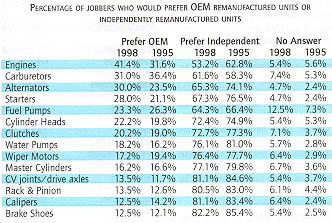
In fact, of 19 product lines sold by jobbers,
18 have higher rebuilt compared to new unit sales compared to
those sold in 1995. In 10 of those product lines jobbers report
that rebuilt units represent 90% or more of all units sold.
The product with the highest percentage of
rebuilt units sold is alternators at 94.1%. Rounding out the top
10 are rack-and-pinions (94%), alternators (93.3%), engine blocks
(93%), calipers (92.1%), crankshafts (92%), power steering pumps
(91.3%), CV axles (91.1%), cylinder heads (90.6%) and transmissions
(90.4%).
Although not representing 90% or more of total
product line sales, carburetors (86.7%), on-board computers (85.9%),
brake shoes (85%), wiper motors (84.5%), A/C compressors (77.3%),
water pumps (66.3%) and master cylinders (66%), all had significantly
higher sales of rebuilt versus new unit sales.
The only product lines with comparative or
fewer rebuilt units versus new units sold were clutches (52.5%
rebuilt) and fuel pumps (13.5% rebuilt). Fuel pumps have been
the product line with the highest percentage of new unit sales
since we began our survey study back in 1988.
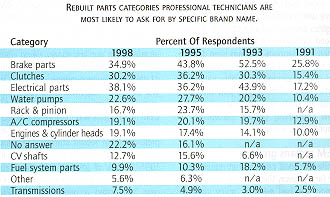
Clutches, on the other hand, began a steady
downward progression of rebuilt unit sales beginning in the early
’90s when the influx of offshore new units available in the market
began to grow, as did the growing number of crimped cover clutch
design equipped vehicles. Since then an increasing number of rebuilders
have become distributors of new rather than manufacturers of rebuilt
units.
The reasons for increasing new unit sales of
clutches are a combination of their attractive price as well as
the difficulty that most rebuilders have when it comes to sourcing
parts for and rebuilding newer crimped cover clutch designs.
Of the 19 product lines surveyed, 14 actually
saw increases in rebuilt versus new unit sales. All product lines
with 90% or more of total sales represented by rebuilt units saw
increases in rebuilt versus new unit sales. One of those product
categories, transmissions, actually rose a staggering 29.6% in
rebuilt versus new unit sales.
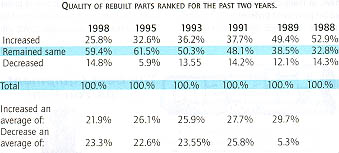
In fact, several other product lines actually
saw significant increases in rebuilt versus new unit sales as
well. CV shafts, for example, rose from 84.8% rebuilt sales in
1995 to 91.1% rebuilt sales in 1998. Cylinder heads also rose
in rebuilt sales from 83.7% to 90.6% in 1998.
The increase in rebuilt unit sales within most
product categories points to the greater value that jobbers continue
to feel these products offer their retail and wholesale customers.
When asked to quantify their purchases of rebuilt parts jobbers
ranked warranty, quality, order fill, price and their previous
experience with the product, in that order, when considering the
purchase of a rebuilt product line.
About seventy-four percent of jobbers said
warranty was most important when making a rebuilt product line
purchasing decision. Warranty was followed by brand quality (69.2%),
order fill (63.4%), price (60.8%) and previous experience with
the product, which was cited by 47.1% of survey respondents.
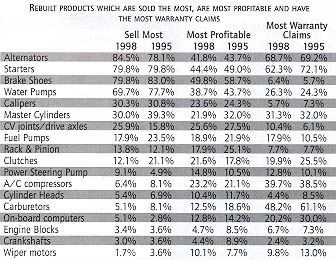
Parts warranty actually showed the largest
percentage increase in importance from our last survey. A little
more than 69% of jobbers cited it as very important in 1995 compared
to 74.5% who ranked it as very important in this year’s survey.
The increase in the length of warranties is
viewed by many rebuilders as an extension of liability, especially
on products such as engines or cylinder heads that can fail within
the warranty period due to customer misuse or service neglect.
On the other hand, extended warranties are
viewed by many in our industry as a necessary marketing tool to
compete with OEM new and remanufactured products, as well as the
rising expectations by consumers for better performance and quality
of vehicle replacement parts.
Unfortunately, a longer warranty does not necessarily
indicate a better product. It’s no secret that many extended warranties
come with a plethora of "small print" which negates
coverage when either the installer or end user does not fulfill
specific criteria. When that happens, little has been done to
enhance the opinion of the installer or the end user concerning
the quality, value and performance of his rebuilt part purchase.
Quite the contrary, a lot of harm has been done concerning positive
perceptions of rebuilt products overall.
OEM remans growing
While the good news is that rebuilt parts are
far and away the preferred replacement option, the bad news for
many independent rebuilders is that OEM rebuilt parts have, in
many cases, seen an increase in jobber purchasing preferences.
Of 14 product lines researched, jobbers reported that they had
increased the percentage of OEM rebuilt versus independently rebuilt
parts in eight of those product lines.
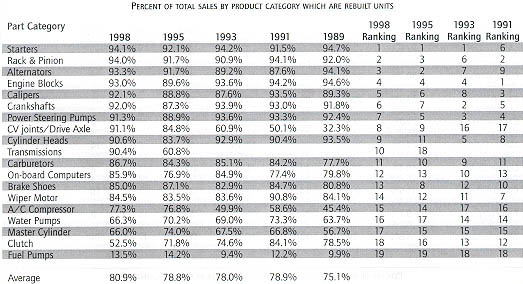
OEM rebuilt engines saw the largest increase
from our last survey, being cited as the preferred replacement
option by 41.4% of survey respondents compared to just 31.6% of
respondents in 1995. The next largest increase in preference for
OEM rebuilt units was in rotating electrics. Twenty-eight percent
of jobbers said they preferred OEM rebuilt starters compared to
just 21% who said so in 1995. And in 1995 23.5% of jobbers said
they preferred OEM rebuilt alternators while this year 30% cited
a preference for OEM remanufactured units.
While the increase in purchasing preferences
was much smaller, usually anywhere from less than 1- 4 percentage
points, jobbers also reported a growing preference for OEM versus
independently rebuilt units in cylinder heads, clutches, water
pumps, CV shafts, rack-and-pinions and brake shoes.
Although the increase in OEM preference for
rebuilt units is marginal in some product categories, and despite
the fact that independently sourced parts still maintain the majority
of market share in all product lines that we surveyed, the overall
trend seems unmistakable.
The cost of warranty work in terms of time,
money and customer inconvenience is a growing issue for many service
technicians. Although usually a more expensive alternative, OEMs
have done a good job of promoting the performance and "original"
replacement part quality of their own remanufactured products.
Judging from the increase across the board in OEM rebuilt unit
sales, it appears more service technicians are listening.
Such trends point to the growing need for quality
rebuilt units. It also points to the need for the independent
aftermarket to continue to fight for access to on-board diagnostic
(OBD) information necessary to ensure that service problems are
diagnosed correctly, and that a replacement part can be rebuilt
and installed properly. Although access to such information is
currently mandated within existing Clean Air legislation, more
than a few OEMs have made it difficult, if not impossible, to
source.
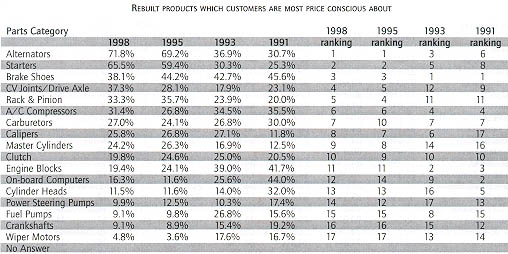
Reinforcing the concern for quality of a rebuilt
replacement part, fewer jobbers said that the quality of rebuilt
parts which they use has increased. In fact, a higher percentage
of jobbers than ever reported that the quality of rebuilt parts
which they purchase has declined.
This year just 25.8% of jobbers reported that
the quality of rebuilt parts which they use has increased over
the past two years. In our 1995 survey, 32.6% of survey respondents
said quality had improved.
In this year’s survey, 14.8% of jobbers reported
that the quality of rebuilt parts, overall, has decreased over
the past two years compared to just 5.9% who said quality levels
had declined in our 1995 survey.
Similarly, for those reporting that quality
had increased, the average increase was less than all previous
years, and for those reporting that quality had decreased, the
average decrease was the highest since 1991.
Survey data indicates that an overwhelming
percentage of jobbers would prefer to see rebuilt parts built
to an industry quality standard. When asked if they would like
to see such a standard developed for rebuilt units, a little more
than 84% of all jobbers responded yes. That compares to 85.4%
who said so in our 1995 survey.
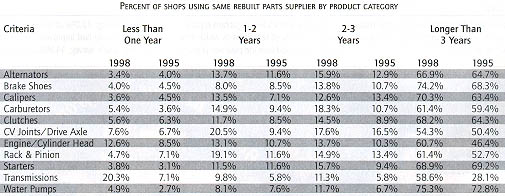
Although the percentage of jobbers saying they
wanted to see a standard for quality developed declined by about
1 percentage point, the percentage of jobbers who said they would
be willing to pay a higher price for units built to such standards
rose significantly. Nearly 80% of survey respondents reported
they would be willing to pay more for a part built to a uniform
quality standard compared to just 72.6% who said they would in
our 1995 survey. The increases in purchasing preferences for many
OEM rebuilt units discussed earlier seems to provide evidence
of such intent.
The price issue
In addition to questions concerning quality,
we also asked jobbers to tell us which rebuilt products their
customers were most price conscious about. The ranking of the
top three rebuilt units in terms of price concerns was the same
as in our 1995 survey.
Alternators, starters and brake shoes were
ranked one, two and three in terms of customer concerns over price.
However, the percentage of jobbers who said price was a top concern
increased for alternators and starters, while the number of jobbers
reporting that price was an issue for brake shoe purchases declined.
Specifically, nearly 72% of jobbers ranked
alternators as one of their top five "price conscious"
products compared to 65.5% who said the same for starters. In
our 1995 survey a little more than 69% of jobbers said alternators
were ranked in the top five price concern products while 59.4%
said the same for starters. A little more than 44% of jobbers
said that brake shoes ranked in the top five price concern products
in 1995 compared to just 38% who said so in this year’s survey.
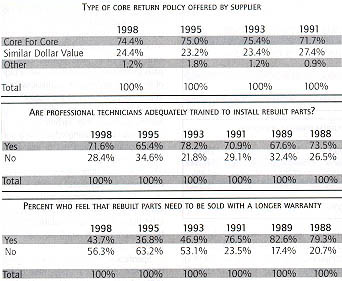
Despite the fact that warranty coverage ranks
as the most important factor when making a rebuilt parts line
purchase decision, price is still a major concern. Rebuilt alternators,
starters, CV shafts, A/C compressors, carburetors, on-board computers,
crankshafts and wiper motors were all rated as more price sensitive
products compared to their 1995 rankings. On the other hand, brake
shoes, rack-and-pinion, calipers, master cylinders, clutches,
engine blocks, power steering pumps and fuel pumps were ranked
as less price sensitive. Of all rebuilt parts sold, wiper motors,
crankshafts and fuel pumps were ranked as the least price sensitive
compared to other rebuilt products.
In general, when trying to understand the impact
of price and warranty when it comes to jobber purchasing decisions,
it is obvious that both the professional service installer and
the consumer have come to expect more.
What sells the most
Topping the list of highest number of units
sold is alternators. A little more than 84% of jobbers said that
alternators were among the top five rebuilt parts sold. Alternators
were followed by starters (79.8%), brake shoes (79.8%), water
pumps (69.7%), calipers (30.3%), master cylinders (30.0%), CV
shafts (25.9%), fuel pumps (17.9%), rack-and-pinions (13.8%) and
clutches (12.1%). All other products each accounted for less than
10% of jobbers ranking them among their top five parts sold.
Although the top 10 volume producers were the
same products listed in our 1995 survey, their rankings changed
somewhat. Among the top three sales leaders, for example, alternators
replaced brake shoes as the number one volume product this year.
In our 1995 survey alternators ranked number three in volume.
Starters retained the number two position in units sold.
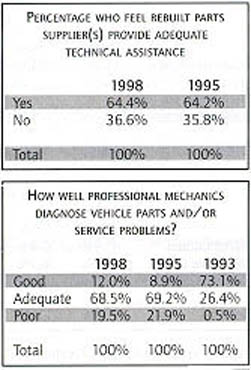
Readers should keep in mind that sales volume
rankings are industry averages. There, of course, are jobbers
who might specialize in certain product lines depending on geographic
location and customer base.
Highest profit products
Although alternators displaced brake shoes
as the leading rebuilt part sold in terms of volume, brake shoes
retained their ranking as the most profitable rebuilt product
line. Nearly 50% of all jobbers ranked brake shoes among the top
five most profitable products they sell. Brake shoes were followed
by starters (44.4%), alternators (41.8%), water pumps (38.7%),
CV shafts (25.6%), calipers (23.6%), A/C compressors (23.2%),
master cylinders (21.9%), clutches (21.6%) and fuel pumps (18.9%).
As with our explanation of sales volume, readers
should keep in mind that profit rankings are industry wide generated
averages. Often times statistics can be just as revealing about
what they don’t say as what they do say. We suspect that some
product rankings in terms of profits are based on "total"
profit dollars generated rather than profit "margins"
of specific product lines.
Jobbers, for example, that may not sell many
crankshafts or engine blocks may not be reporting these products
as higher profit generating products compared to alternators and
starters which they sell in significant numbers.
Highest warranty products
We also asked jobbers to tell us which products
were among their highest warranty returns. Alternators were number
one on jobbers’ headache list, claimed by nearly 69% of jobbers
to be among the top five products returned as a warranty claim.
Alternators were followed by starters (62.3%),
carburetors (48.2%), A/C compressors (39.7%), master cylinders
(31.3%), water pumps (26.3%), on-board computers (20.2%), clutches
(19.9%), fuel pumps (17.9%) and power steering pumps (12.8%).
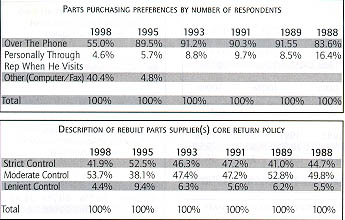
Although the percentage of jobbers ranking
alternators and starters within the top two warranty return categories
was lower, these two products repeated in the top two categories
again this year. Jobbers said both professional installers and
do-it-yourselfers continue to make unintended misdiagnosis of
vehicle electrical system problems. So, too, do they sometimes
install rebuilt units as diagnostic tools to help locate the actual
no-start or charging problem on the vehicle.
Computer controlled vehicles increasingly present
both retail and wholesale purchasers of rebuilt units with diagnostic
and correct installation problems. Warranty return rankings of
these two units, especially, point to the continued need for the
rebuilding industry to fight for access to on-board diagnostic
tools and information from the OEMs in order to make properly
rebuilt units available. They also point to the importance of
rebuilders having the proper testing equipment to ensure that
rebuilt units operate as they should.
As our survey results indicate, the expectations
for higher quality rebuilt parts are rising. But so are those
for proper diagnosis and installation. Survey results indicate
that jobbers are more pleased with the diagnostic and installation
skills of professional installers.
When asked if professional technicians are
adequately trained to install rebuilt parts, 71.6% of jobbers
responded yes. It is the highest percentage ever reported, and
an increase of a little more than 6 percentage points compared
to the 65.4% of jobbers who said technicians were adequately trained
in our 1995 survey.
Although the percentage point increases were
marginal in most product lines, all parts showed an increase in
the percentage of time that professional technicians were able
to correctly diagnose the original vehicle part or system problem.
This year 12% of jobbers reported that technicians did a "good"
job of diagnosing vehicle parts and service problems compared
to just 8.9% who said so in 1995.
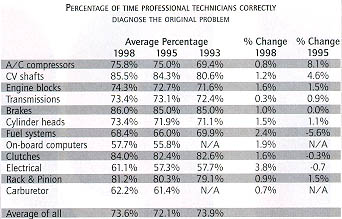
A little more than 68% said that technicians
did an "adequate" job (69.2% said so in 1995) of diagnosing
parts and service problems, while 19.5% said technicians did a
"poor" job on vehicle diagnostic work compared to nearly
22% who said so in our 1995 survey.
Specifically, the parts with the highest diagnostic
satisfaction ratings were brakes (86% of jobbers said problems
with them were correctly diagnosed), followed by CV shafts (85.5%),
clutches (84%), rack-and-pinions (81.2%), A/C compressors (75.8%),
engine blocks (74.3%), cylinder heads (73.4%), transmissions (73.4%),
fuel systems (68.4%) and carburetors (62.2%). Electrical (61.1%)
and on-board computers (57.7%) received the lowest satisfaction
ratings when it came to proper diagnostic work by professional
technicians. There has been an increase in the satisfaction with
technician diagnostic and installation work. But when just 12%
of jobbers say that technicians do a "good" job at it,
there remains a lot of improvement work yet to be realized.
Lastly, we asked jobbers for their perspectives
on sourcing, core policy, length of time doing business with the
same supplier, preference for product packaging, training and
sales/promotion support.
With the industry-wide number of consolidations
taking place among both suppliers and rebuilders you would think
that more jobbers would be purchasing their parts from a single
supplier. However, more jobbers said they preferred sourcing their
parts from multiple sources. This year 41.8% of jobbers reported
a preference for using multiple suppliers compared to 39.8% who
said so in 1995.
The length of time that jobbers have stayed
with a source of rebuilt product has increased virtually across
all product lines. We asked jobbers to indicate the number of
years they had used the same supplier in 11 different product
categories. In the three years or longer category, the percentage
of jobbers responding was higher in every product line except
for starters where it declined less than 1 percentage point.
Transmissions and engines/cylinder heads showed
the largest increase in the number of jobbers that have used the
same source for three years or more. Interestingly, the largest
percentage of jobbers indicating they had used a supplier for
less than one year was also in the transmissions and engines/cylinder
head categories. This seems to indicate there are many jobbers
who are unhappy with their current source in these product lines,
however, once they find a source for those products they like,
they are reluctant to change. The higher cost in inventory, warranty
and customer satisfaction are the likely explanation.
Not much has changed in terms of core return
policies. Nearly three-quarters of all jobbers report that their
suppliers require a core-for-core return policy compared to 75%
who said so in 1995. Those receiving a "similar dollar value"
core policy rose from 23.2% in 1995 to 24.4% this year.
Although fewer jobbers reported that their
core return policies were "strictly" controlled ( 41.9%
this year versus 52.5% in 1995), a significantly higher number
(53.7%) said their core return policies were "moderately"
enforced compared to just 38.1% who said so in 1995.
Part number proliferation and the desire to
reduce inventory and warranty expenses, wherever possible, are
the primary reasons for more stringent control of core returns.
In most product lines, profit margins are being squeezed and rebuilders
are being forced to implement more efficient core return policies.
As to rebuilder efforts to promote and advertise
rebuilt products, jobbers ranked the personal sales call as the
most effective sales tool. The personal sales call was also number
one in 1995, although the percentage of jobbers saying it was
most effective rose from 31.6% in 1995 to 35.6% this year.
The personal sales call was followed by seminars/technical
clinics (31.3%), trade magazine advertising (10.7%), direct mail
(7.7%) and telemarketing (0.4%) as the most effective sales and
promotional tools of rebuilders.
Once a decision was made to buy, however, preferences
for the best procedure for placing an order have changed dramatically.
In 1995, 89.5% of jobbers said that the telephone was the preferred
way to order parts. This year, just 55% of jobbers said so.
The telephone still ranks as the most popular
method for placing an order. However, where just 4.8% of jobbers
said the computer/fax was the best approach to order placement
in 1995, a whopping 40.4% of jobbers said it was the preferred
method for placing an order this year.
In sum, there seems to be no question that
technology continues to significantly impact vehicle diagnostics
and parts installation, as well as the way in which rebuilt parts
are purchased, processed and rebuilt.













